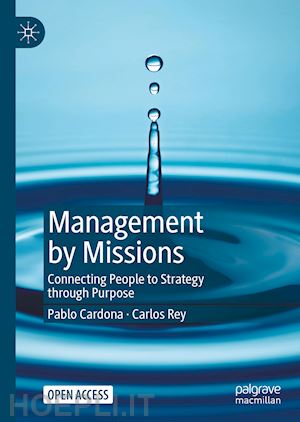

Questo prodotto usufruisce delle SPEDIZIONI GRATIS
selezionando l'opzione Corriere Veloce in fase di ordine.
Pagabile anche con Carta della cultura giovani e del merito, 18App Bonus Cultura e Carta del Docente
A few decades ago, management thinking started to embrace the idea of purpose. The first edition of this book marked an important step in this trajectory; it drew attention to the need for managers to relate the concepts of ‘purpose’ and ‘missions’ to strategy, culture and leadership. In the years since, purpose and missions have become business imperatives – not only in terms of remaining competitive but as core in the attempts to have a sustainable impact on the world.
The second edition of Management by Missions is an open access book based on substantially more research carried out over fifteen years, involving more than 200 organizations around the world. All of this research supports that the practical models and ideas offered in the book have been tried and tested and actually work in practice.
With case studies, anecdote and new research findings, the authors present the main tools of the MBM method (shared missions, missions scorecards, interdependency matrix, missions-based objectives and integral assessment) and the type of leadership needed to implement it. The ideas presented in this book mark a path towards a new management methodology for the XXI century and a new way of understanding the work that managers do.
Part I. Myths and realities of management
1. Is there a link between corporate culture and profit?
In this chapter we further develop the concept of organizational Unity and our initial findings with recent research about the relationship between organizational culture and long-term profitability. Four kind of cultures are identified: paternalistic, bureaucratic, aggressive and competent. The implications of the cultural types and the new demands of society are discussed.
2. Different ways of understanding an organization
In this chapter we discuss about three different logics of an organization: mechanical, organic and anthropological and their implications for management practices. This perspectives are updated with the recent theories and findings on corporate culture and purpose, as well with new an updated examples.
3. What are companies for
This chapter focuses on the role of company’s purpose and how to balance purpose with profit maximization and stakeholder interest. Recent theories and research - like Shared Value Creation or Hybrid organizations with “dual purposes”- are discussed, offering examples and recommendations on how to develop purpose in the equilibrium and complementarity amongst the different ends of a company.
Part II. In search of purpose
4. Cultural problems today
In this chapter we discuss the main cultural problems of today’s organization (e.g. low levels of engagement, bad communication, low cooperation, lack of shared meaning, inefficient bureaucracy), the limits of Management by Objectives (MBO) and the need for an new management practice that overcome these limitations. This chapter is updated with recent research and findings that support our initial assumptions about the shortcomings of MBO for contemporary business and also bring to the discussion recent solution and proposals for MBO improvement.
5. The missions of a company
This chapters presents, with multiple examples, how to articulate the purpose of a company by means of missions addressed to the different stakeholders of the company. After discussing the role of missions as source of pro-stakeholders motivation, recommendations for effective mission’s development are provided in three dimensions: coherence, authenticity and integrity.6. The values of a balanced culture
This chapter presents the crucial role of balanced values in the development of a purpose driven. We update the proposal about values we made in the first edition with recent research from ours or others that test this theory on different sets of Fortune 100 companies, Fortune 500, and companies from the Best to Work index. Recommendations and guidance for managers are provided.
Part III. A new management model
7. The purpose chart
This chapter presents the foundations, cases and practical examples of three main tools of Management by Missions methodology: “shared missions” (deployment of corporate missions into team and individual missions at all levels of the company), “interdependency matrix” (cross-functional missions) and “purpose scorecards” (an evolution of the traditional balanced scorecard). All together form the purpose chart, a time-tested methodology for the development of purpose in organizations.
8. Purpose-driven tools
This chapter show, with practical examples and cases, how to evolve traditional management tools introducing purpose and missions as an overarching source of unity and alignment. It covers four areas of interconnected tools: strategic planning, purpose driven objectives, competence development and performance appraisal.
9. Missions driven leadership
This chapter presents three different types of leadership styles -transactional, transformational and transcendent- and how they are related with the practice of management by missions. Practical recommendations on how to develop missions driven leadership, stories, and anecdotes are structured around three dimensions: shared commitment, cooperation and change.











Il sito utilizza cookie ed altri strumenti di tracciamento che raccolgono informazioni dal dispositivo dell’utente. Oltre ai cookie tecnici ed analitici aggregati, strettamente necessari per il funzionamento di questo sito web, previo consenso dell’utente possono essere installati cookie di profilazione e marketing e cookie dei social media. Cliccando su “Accetto tutti i cookie” saranno attivate tutte le categorie di cookie. Per accettare solo deterninate categorie di cookie, cliccare invece su “Impostazioni cookie”. Chiudendo il banner o continuando a navigare saranno installati solo cookie tecnici. Per maggiori dettagli, consultare la Cookie Policy.